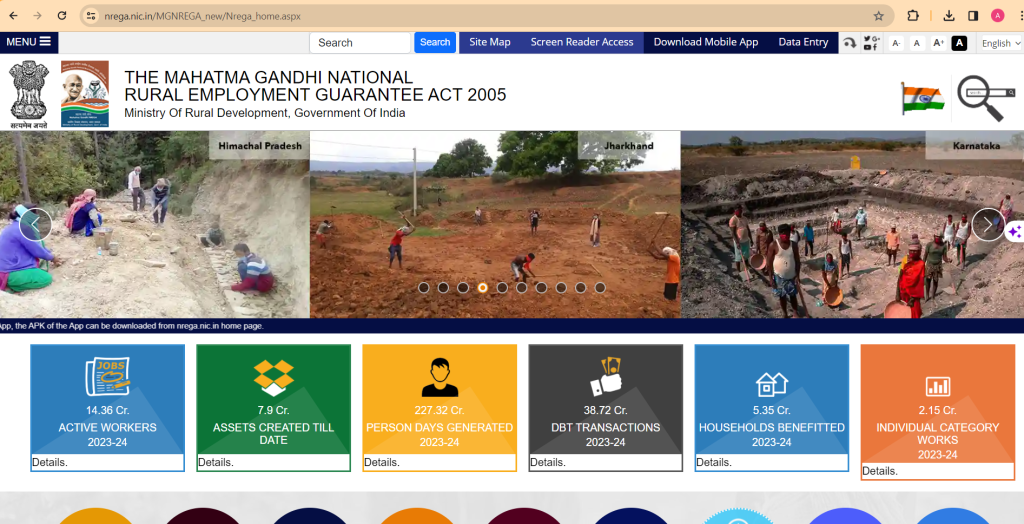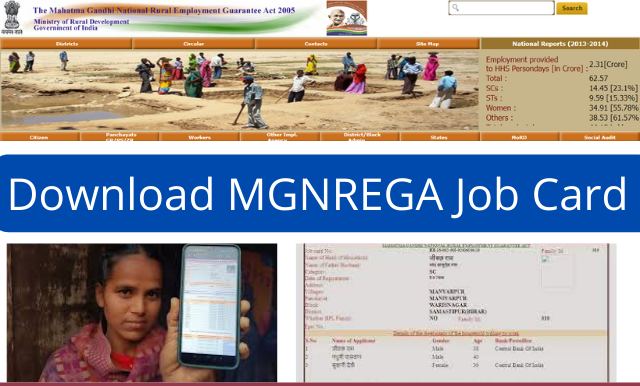The Mahatma Gandhi National Rural Employment Guarantee00 Act MGNREGA Job Card is an integral part of one of India’s most ambitious social welfare programs. This detailed article explores the multifaceted aspects of the MGNREGA Job Card, shedding light on its purpose, operational mechanics, benefits, and the profound impact it has had on rural employment in India.
Introduction to MGNREGA Job Card
Launched in 2005, the Mahatma Gandhi National Rural Employment Guarantee Act represents a significant stride in India’s efforts to combat rural poverty and unemployment. As a groundbreaking labor law, MGNREGA’s primary goal is to secure livelihoods in rural areas by assuring at least 100 days of paid employment each financial year to every household with adults willing to engage in unskilled manual labor. This initiative stands as a testament to the Indian government’s commitment to creating sustainable employment opportunities while addressing rural distress.
The MGNREGA Job Card

Purpose and Issuance
The MGNREGA Job Card serves as a cornerstone of this scheme. Issued by local Gram Panchayats (village councils), this document is pivotal for households in rural India registering for employment under the Act. Its roles are multifaceted:
- Identity Verification: The Job Card verifies the identity of the household members and their eligibility for work under MGNREGA.
- Record Keeping: It meticulously documents each member’s labor contributions, the duration of employment, and the wages received, thereby ensuring a clear record of work and payment.
- Enhancing Transparency and Accountability: The card plays a crucial role in maintaining transparency in the scheme’s operations and holding local authorities accountable for fair wage distribution and employment provision.
Issuance of the Job Card is contingent upon an application by the household to the local Gram Panchayat, supported by necessary identity and residence proofs.
Features and Information Contained
A typical MGNREGA Job Card includes comprehensive details:
- Household Details: It lists the names and photographs of all eligible adult household members.
- Work Records: The card records specifics of the allotted work, the number of days worked, and the corresponding wages earned by each member.
- Bank Account Details: To facilitate direct and transparent transfer of wages, it includes bank account details of the members.
Application Process
The process to obtain a Job Card is straightforward but vital:
- Submission of an application to the local Gram Panchayat is the first step.
- This is followed by providing necessary documents like identification and residence proofs.
- Post verification, the Gram Panchayat issues the Job Card to the eligible household.
Benefits of the MGNREGA Job Card
- Guarantee of Employment: The Job Card empowers rural households by assuring them of their right to work.
- Promotion of Financial Inclusion: The practice of direct wage transfers linked with the Job Card promotes financial literacy and inclusion among rural populations.
- Empowerment of Marginalized Communities: It facilitates the participation of women and socially marginalized groups, ensuring equitable access to employment opportunities.
- Skill Development Opportunities: While MGNREGA work is predominantly unskilled, it often leads to skill development, particularly in areas like water conservation, land development, and infrastructure.
Check the MGNREGA Job Card List Online
To check the latest MGNREGA Job Card list online in a concise manner, follow these simplified steps:
- Visit the Official MGNREGA Website: Access the official MGNREGA portal designated by the Indian government.
- Select Your State: Choose your respective state from the list provided on the homepage.
- Go to Job Card Section: Locate and click on the ‘Job Card’ section, typically found under headings like ‘Transparency & Accountability’ or ‘Reports’.
- Enter Required Details: Input necessary information such as Financial Year, District, Block, and Panchayat to narrow down your search.
- View Job Card List: Submit your query to display a list of job cards for the selected area, showing details like job card numbers and beneficiary names.
- Search for Specific Information: Use the search function, if available, to find specific job cards using names or job card numbers.
- Access Detailed Information: Click on a job card number to view detailed information including work records, days worked, and wages.
Key Points to Remember
- Regularly check for updates on the site.
- Ensure you are using the official MGNREGA website.
- Keep your job card and personal details ready for reference.
This online facility allows for easy verification of employment records and promotes transparency in the MGNREGA scheme.
Impact on Rural Employment
The MGNREGA Job Card has been a catalyst in transforming rural employment in India:
- Mitigation of Rural-Urban Migration: By offering local employment opportunities, it has significantly reduced the need for rural inhabitants to migrate to urban areas in search of work.
- Upliftment in Rural Wages: The scheme has been instrumental in increasing the general wage levels in rural areas.
- Providing Social Security: The Job Card serves as a critical safety net for the rural poor, particularly during times of agricultural off-season or economic downturns.
Challenges and Way Forward
Despite its success, the MGNREGA program, and by extension the Job Card system, face several challenges, such as bureaucratic delays in wage payments and concerns of corruption and mismanagement. To enhance the effectiveness and reach of this program, it is imperative to strengthen the monitoring systems, ensure transparency in operations, and facilitate timely payment of wages.
Conclusion
The MGNREGA Job Card is emblematic of India’s commitment to rural development and social welfare. It’s a beacon of hope and a tool for empowerment, economic stability, and social upliftment in rural India. As MGNREGA continues to evolve, the Job Card is poised to play an even more significant role in ensuring that the benefits of this transformative scheme efficiently reach its intended beneficiaries, thus contributing to the broader goal of poverty alleviation and rural development in India.

